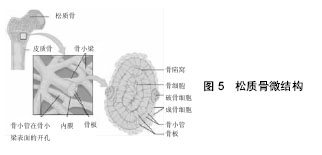| [1] Hui SL, Slemenda CW, Johnston CC Jr. Age and bone mass as predictors of fracture in a prospective study. J Clin Invest. 1988;81(6): 1804-1809.
[2] Knudtson M. Osteoporosis: Background and Overview. J Nurs Prac. 2009;5(6): S4-S12.
[3] Hernandez CJ, Keaveny TM. A biomechanical perspective on bone quality. Bone. 2006;39(6): 1173-1181.
[4] Diab T, Vashishth D. Effects of damage morphology on cortical bone fragility. Bone. 2005;37(1): 96-102.
[5] Courtney AC, Hayes WC, Gibson LJ. Age-related differences in post-yield damage in human cortical bone. Experiment and model. J Biomech. 1996;29(11): 1463-1471.
[6] Burr DB, Turner CH, Naick P, et al. Does microdamage accumulation affect the mechanical properties of bone? J Biomech. 1998;31(4): 337-345.
[7] Vashishth D, Koontz J, Qiu SJ, et al. In vivo diffuse damage in human vertebral trabecular bone. Bone. 2000;26(2): 147-152.
[8] Yeni YN, Hou FJ, Ciarelli T, et al. Trabecular Shear Stresses Predict In Vivo Linear Microcrack Density but not Diffuse Damage in Human Vertebral Cancellous Bone. Ann Biomed Eng. 2003;31(6): 726-732.
[9] Fazzalari NL, Forwood MR, Manthey BA. Three-dimensional confocal images of microdamage in cancellous bone. Bone. 1998;23(4): 373-378.
[10] Boyce TM, Fyhrie DP, Glotkowski MC, et al. Damage type and strain mode associations in human compact bone bending fatigue. J Orthop Res. 1998;16(3): 322-329.
[11] Diab T, Condon Kwburr DB, Vashishth D. Age-related change in the damage morphology of human cortical bone and its role in bone fragility. Bone. 2006;38(3): 427-431.
[12] Reilly GC, Currey JD. The development of microcracking and failure in bone depends on the loading mode to which it is adapted. J Exp Biol. 1999; 202(202): 543-52.
[13] Seref-Ferlengez Z, Basta-Pljakic J, Kennedy OD, et al. Structural and Mechanical Repair of Diffuse Damage in Cortical Bone In Vivo. J Bone Miner Res. 2014;29(12): 2537-2544.
[14] Frost H. Presence of microscopic cracks in vivo in bone. Henry Ford Hosp Med Bull. 1960;8(2): 35.
[15] Burr DB, Stafford T. Validity of the bulk-staining technique to separate artifactual from in vivo bone microdamage. Clin Orthop Relat Res. 1990;260(260): 305-308.
[16] Lee TC, Myers ER, Hayes WC. Fluorescence-aided detection of microdamage in compact bone. J Anatomy. 1998;193(Pt 2): 179-184.
[17] Huja SS, Hasan MS, Pidaparti R, et al. Development of a fluorescent light technique for evaluating microdamage in bone subjected to fatigue loading. J Biomech. 1999;32(11): 1243-1249.
[18] Lee TC, Arthur TL, Gibson LJ, et al. Sequential labelling of microdamage in bone using chelating agents. J Orthop Res. 2000;18(2):322-325.
[19] O’Brien FJ, Taylor D, Lee TC. An improved labelling technique for monitoring microcrack growth in compact bone. J Biomech. 2002;35(4): 523-526.
[20] O’Brien FJ, Taylor D, Lee TC. Microcrack accumulation at different intervals during fatigue testing of compact bone. J Biomech. 2003;36(36): 973-980.
[21] Burt-Pichat B, Follet H, Toulemonde G, et al. Methodological approach for the detection of both microdamage and fluorochrome labels in ewe bone and human trabecular bone. J Bone Miner Metab. 2011;29(29): 756-764.
[22] Beck JD, Canfield BL, Haddock SM, et al. Three-dimensional imaging of trabecular bone using the computer numerically controlled milling technique. Bone. 1997;21(3): 281-287.
[23] Kazakia GJ, Lee JJ, Singh M, et al. Automated high-resolution three-dimensional fluorescence imaging of large biological specimens. J Microsc. 2007;225(Pt 2): 109-117.
[24] Bigley RF, Singh M, Hernandez CJ, et al. Validity of serial milling-based imaging system for microdamage quantification. Bone. 2008;42(1): 212-215.
[25] Slyfield CR, Niemeyer KE, Tkachenko EV, et al. Three-dimensional surface texture visualization of bone tissue through epifluorescence-based serial block face imaging. J Microsc. 2009;236(1): 52-59.
[26] Tkachenko EV, Slyfield CR, Tomlinson RE, et al. Voxel size and measures of individual resorption cavities in three-dimensional images of cancellous bone. Bone. 2009;45(3): 487-492.
[27] Slyfield CR, Tkachenko EV, Wilson DL, et al. Three-dimensional dynamic bone histomorphometry. J Bone Miner Res. 2012;27(2): 486-495.
[28] Goff MG, Lambers FM, Sorna RM, et al. Finite element models predict the location of microdamage in cancellous bone following uniaxial loading. J Biomech. 2015;48(15): 4142-4148.
[29] Zioupos P, Currey JD, Sedman AJ. An examination of the micromechanics of failure of bone and antler by acoustic emission tests and Laser Scanning Confocal Microscopy. Med Eng Phys. 1994;16(3): 203-212.
[30] O'Brien FJ, Taylor D, Dickson GR, et al. Visualisation of three-dimensional microcracks in compact bone. J Anat. 2000;197 Pt 3(3): 413-420.
[31] Zioupos P. Accumulation of in-vivo fatigue microdamage and its relation to biomechanical properties in ageing human cortical bone. J Microsc. 2001;201(201): 270-278.
[32] Diab T, Vashishth D. Morphology, localization and accumulation of in vivo microdamage in human cortical bone. Bone. 2007;40(3): 612-618.
[33] Poundarik AA, Diab T, Sroga GE, et al. Dilatational band formation in bone. Proc Nat Acad Scie. 2012; 109(47): 19178-19183.
[34] Feldkamp LA, Davis LC, Kress JW. Practical cone-beam algorithm. J Opt Soc Am. 1984;1(6): 612-619.
[35] Layton MW, Feldkamp LA, Ms DJ, et al. Examination of subchondral bone architecture in experimental osteoarthritis by microscopic computed axial tomography. Arthritis Rheum. 1988;31(11): 1400-1405.
[36] Kuhn JL, Goldstein SA, Feldkamp LA, et al. Evaluation of a microcomputed tomography system to study trabecular bone structure. J Orthop Res. 1990;8(6): 833-842.
[37] Feldkamp LA, Goldstein SA, Parfitt MA, et al. The direct examination of three-dimensional bone architecture in vitro by computed tomography. J Bone Miner Res.1989;4(1): 3-11.
[38] Leng H, Vandersarl J, Niebur G, et al. Microdamage in bovine cortical bone measured using micro- computed tomography. Trans Orthop Res Soc. 2005;30: 665.
[39] Parkesh R, Mohsin S, Tc L, et al. Histological, Spectroscopic, and Surface Analysis of Microdamage in Bone: Toward Real-Time Analysis Using Fluorescent Sensors. Chem Mater. 2007;19(7): 1656-1663.
[40] Parkesh R, Lee TC, Gunnlaugsson T, et al. Microdamage in bone: surface analysis and radiological detection. J Biomech. 2006;39(39): 1552-1556.
[41] Tang SY, Vashishth D. A non-invasive in vitro technique for the three-dimensional quantification of microdamage in trabecular bone. Bone. 2007;40(5): 1259-1264.
[42] Leng H, Wang X, Ross RD, et al. Micro-computed tomography of fatigue microdamage in cortical bone using a barium sulfate contrast agent. J Mech Behav Biomed Mater. 2008;1(1):68-75.
[43] Wang X, Masse DB, Leng H, et al. Detection of trabecular bone microdamage by micro-computed tomography. J Biomech. 2007;40(15): 3397-3403.
[44] Turnbull TL, Gargac JA, Niebur GL, et al. Detection of Fatigue Microdamage in Whole Rat Femora Using Contrast-Enhanced Micro-Computed Tomography. J Biomech. 2011;44(13): 2395-2400.
[45] Turnbull TL, Baumann AP, Roeder RK. Fatigue microcracks that initiate fracture are located near elevated intracortical porosity but not elevated mineralization. J Biomech. 2014;47(12): 3135-3142.
[46] Grodzins L. Optimum energies for x-ray transmission tomography of small samples: Applications of synchrotron radiation to computerized tomography I. Nucl Instr Methods Phys Res. 1983;206(3): 541-545.
[47] Bonse U, Busch F, Günnewig O, et al. 3D computed X-ray tomography of human cancellous bone at 8 μm spatial and 10- 4 energy resolution. Bone Miner. 1994; 25(1): 25-38.
[48] Engelke K, Graeff W, Meiss L, et al. High Spatial Resolution Imaging of Bone Mineral Using Computed Microtomography: Comparison with Microradiography and Undecalcified Histologic Sections. Invest Radiol. 1993;28(4): 341-349.
[49] Lane NE, Haupt D, Kimmel DB, et al. Early estrogen replacement therapy reverses the rapid loss of trabecular bone volume and prevents further deterioration of connectivity in the rat. J Bone Miner Res. 1999;14(2): 206-214.
[50] Salomé M, Peyrin F, Cloetens P, et al. A synchrotron radiation microtomography system for the analysis of trabecular bone samples. Med Phys. 1999;26(10): 2194-2204.
[51] Stampanoni M, Borchert G, Wyss P, et al. High resolution X-ray detector for synchrotron-based microtomography. Nucl Instr Methods Phys Res. 2002;491(1-2): 291-301.
[52] Snigireva I, Snigirev A. X-Ray microanalytical techniques based on synchrotron radiation. J Environ Monit. 2006;8(1): 33-42.
[53] Ito M, Ejiri S, Jinnai H, et al. Bone structure and mineralization demonstrated using synchrotron radiation computed tomography (SR-CT) in animal models : preliminary findings. J Bone Miner Metab. 2003;21(5): 287-293.
[54] Thurner PJ, Wyss P, Voide R, et al. Time-lapsed investigation of three-dimensional failure and damage accumulation in trabecular bone using synchrotron light. Bone. 2006;39(2): 289-299.
[55] Larrue A, Rattner A, Laroche N, et al. Feasibility of micro-crack detection in human trabecular bone images from 3D synchrotron microtomography. Conf Proc IEEE Eng Med Biol Soc. 2007;2007:3918-21.
[56] Voide R, Schneider P, Stauber M, et al. Time-lapsed assessment of microcrack initiation and propagation in murine cortical bone at submicrometer resolution. Bone. 2009;45(2): 164-173.
[57] Dyson ED, Jackson CK, Whitehouse WJ. Scanning electron microscope studies of human trabecular bone. Nature. 1970;225(5236): 957-959.
[58] Whitehouse WJ, Dyson ED, Jackson CK. The scanning electron microscope in studies of trabecular bone from a human vertebral body. J Anat. 1971; 108 (Pt 3): 481-496.
[59] Vashishth D, Behiri JC, Bonfield W. Crack growth resistance in cortical bone: concept of microcrack toughening. J Biomech. 1997;30(8): 763-769.
[60] Goldstein JI, Newbury DE, Echlin P, et al. Scanning electron microscopy and X-ray microanalysis. A text for biologists, Mat Sci Geol. 1981: 469-484.
[61] Schaffler MB, Pitchford WC, Choi K, et al. Examination of compact bone microdamage using back-scattered electron microscopy. Bone. 1994;15(5): 483-488.
[62] Braidotti P, Branca F P, Stagni L. Scanning electron microscopy of human cortical bone failure surfaces. J Biomech. 1997;30(2): 155-162.
[63] Wise LM, Wang Z, Grynpas MD. The use of fractography to supplement analysis of bone mechanical properties in different strains of mice. Bone. 2007;41(4): 620-630.
[64] Carriero A, Zimmermann EA, Shefelbine SJ, et al. A methodology for the investigation of toughness and crack propagation in mouse bone. J Mech Behav Biomed Mater. 2014;39:38-47.
[65] Carriero A, Zimmermann EA, Paluszny A, et al. How Tough Is Brittle Bone? Investigating Osteogenesis Imperfecta in Mouse Bone. J Bone Miner Res. 2014; 29(6):1392-1401. |
.jpg)



.jpg)